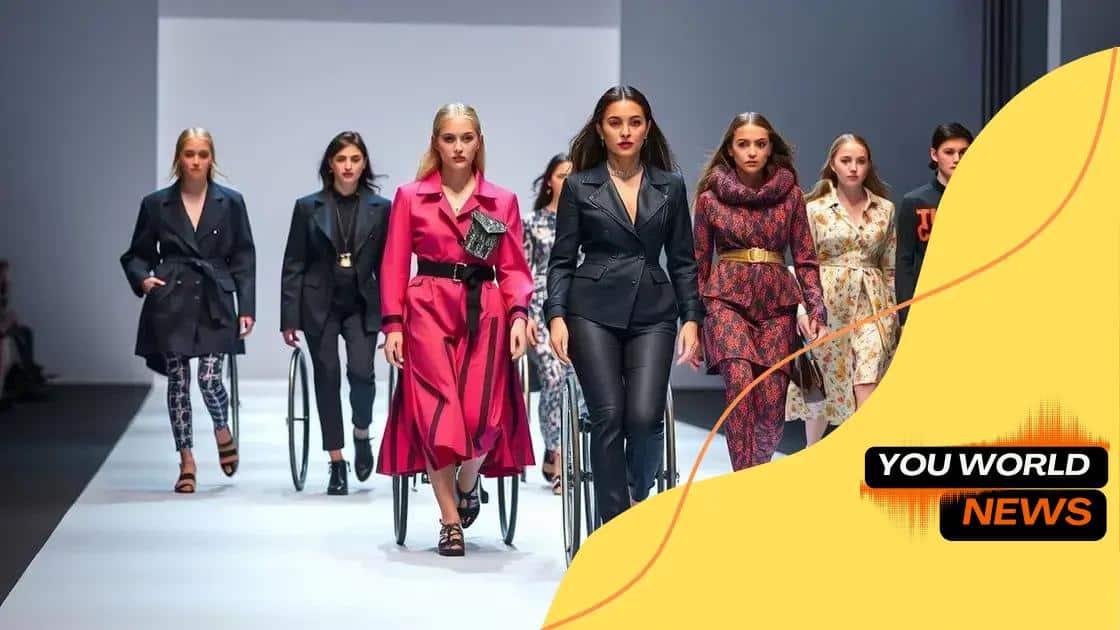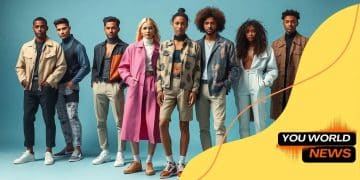The growing market for adaptive fashion: why it matters

The growing market for adaptive fashion focuses on creating stylish, functional clothing for individuals with disabilities, enhancing inclusivity and promoting self-expression through innovative designs and sustainable practices.
The growing market for adaptive fashion offers exciting developments aimed at inclusivity and style. Ever thought about how fashion can be made accessible for everyone? Let’s dive into this evolving landscape.
Understanding adaptive fashion
Understanding adaptive fashion is crucial in today’s diverse world. This approach to clothing focuses on versatility and accessibility, ensuring that fashion is inclusive for all individuals, regardless of their physical abilities. It’s about blending style with functionality, creating pieces that contribute to a person’s self-expression.
What is Adaptive Fashion?
Adaptive fashion refers to clothing that is designed specifically for people with disabilities or unique needs. These garments often include features like adjustable closures, magnetic buttons, and easy-to-wear designs. The goal is to make dressing easier and more comfortable. For example, clothing may be designed to accommodate wheelchairs or sensory sensitivities.
Key Benefits of Adaptive Fashion
- Increased independence in dressing
- Improved comfort and fit
- Enhanced personal style for users
- Greater representation in the fashion industry
As more brands embrace adaptive fashion, we see an increase in options that cater specifically to diverse needs. Designers are working hard to ensure that these clothes are not just practical, but also stylish. This shift is essential for building a more inclusive society.
In addition, adaptive clothing encourages people to express their individuality. By incorporating trendy designs and colors, individuals can wear what they love without compromising on ease of use. The essence of adaptive fashion lies in ensuring that everyone has the right to look and feel great.
Looking forward, the adaptive fashion market is poised for further growth. Awareness campaigns and consumer demand are pushing brands to innovate continually. As we understand more about the importance of inclusivity in fashion, the journey for accessibility continues.
The impact of adaptive fashion on inclusivity
The impact of adaptive fashion on inclusivity is profound and growing. Adaptive fashion plays a vital role in ensuring everyone can participate in style, regardless of their physical abilities. This field is reshaping perceptions and opening doors in the fashion industry.
Enhancing Visibility and Representation
One key aspect of adaptive fashion is its ability to enhance visibility for individuals with disabilities. By featuring models of all abilities, brands are showcasing a more accurate representation of society. When people see themselves in media and products, it fosters a sense of belonging. This visibility inspires confidence and encourages self-expression among those who might feel marginalized.
Breaking Down Barriers
Adaptive fashion also breaks down barriers related to accessibility. Many designs focus on practical features that promote independence, such as easy closures and comfortable fits. These innovations remove the stigma that often surrounds traditional clothing. They create a more inclusive environment where everyone can choose their style without limitations.
- Features like Velcro or magnetic buttons simplify dressing.
- Stretch fabrics provide comfort for all body types.
- Fashion-forward designs can cater to diverse needs.
As brands embrace adaptive clothing, they not only reach a broader audience but also expand their customer base. This shift challenges stereotypes and pushes for a culture where everyone’s preferences and needs are considered in fashion design.
The explosion of interest in adaptive fashion reflects a growing understanding of what inclusivity truly means. As people advocate for representation in all areas of life, adaptive fashion is leading the charge. It reinforces the belief that everyone deserves to wear clothes that are both fashionable and functional.
Key players in the adaptive fashion market

The adaptive fashion market is seeing the rise of several key players who are changing the landscape of inclusive clothing. These brands recognize the importance of providing stylish and functional options for individuals with diverse needs. Their contributions are remarkable in promoting accessibility within the fashion industry.
Notable Brands in Adaptive Fashion
Many brands have stepped up to offer adaptive collections that emphasize both style and practicality. These companies focus on innovative designs that help wearers feel confident and comfortable. Some of the notable brands include:
- Tommy Hilfiger: Known for their inclusive collections, they provide stylish clothing options with adaptive features.
- Zappos: They offer a wide range of adaptive clothing and footwear, ensuring that accessibility is a priority.
- ASOS: Their adaptive line includes versatile pieces tailored for different needs, making fashion accessible.
- Target: This retail giant has embraced adaptive clothing, showcasing a variety of options for all ages.
These brands not only provide necessary clothing but also raise awareness about the importance of adaptive fashion in our society. As they gain visibility, they inspire other companies to follow suit and adopt similar practices. The drive towards inclusivity is transforming how fashion is perceived.
Today, more designers are collaborating with individuals who have disabilities to ensure that clothing meets their specific needs. This collaboration leads to unique and inventive styles that resonate with a broader audience. Not only do these key players highlight the need for adaptive clothing, but they also promote a culture of acceptance and understanding.
The adaptive fashion market’s growth reflects a changing mindset regarding style and accessibility. As consumers demand more equitable options, these brands are at the forefront, pushing the industry towards a brighter future.
Challenges faced by adaptive fashion designers
Challenges faced by adaptive fashion designers are numerous and complex. Adaptive fashion requires a careful balance between style and functionality. Designers must ensure that their creations are not only trendy but also easy to wear for individuals with various disabilities.
Design Constraints
One significant challenge is the design constraints that come with making clothing more accessible. Traditional design elements often do not work for adaptive wear. Designers must explore new methods to create clothing that meets the needs of different physical abilities while still appealing to a fashion-forward audience.
Material Selection
Choosing the right materials is another hurdle. Some fabrics may pose challenges for those with sensory sensitivities, leading designers to seek alternatives that offer comfort without sacrificing style. For instance, clothing may need to avoid seams or rough textures that can cause irritation.
- Soft and stretchy fabrics for comfort.
- Breathable materials to enhance wearability.
- Durable options that withstand everyday use.
Another issue many designers face is securing funding and support for their adaptive collections. Many investors may not see the immediate market potential, creating barriers for new initiatives. As a result, designers often rely on their creativity and passion to bring their visions to life.
Furthermore, raising awareness about the importance of adaptive fashion is crucial. Many consumers are still unaware of the available options, limiting the market’s growth. Designers play a key role in educating the public and advocating for greater inclusivity in the fashion industry.
Overall, despite these challenges, adaptive fashion designers are making great strides. Their commitment to inclusivity and innovation is changing the landscape of fashion, allowing everyone to express themselves through clothing.
Future trends in adaptive fashion
Future trends in adaptive fashion promise exciting developments as the industry continues to evolve. Adaptive fashion is shifting not only in how clothing is made but also in how it is perceived by consumers and designers alike.
Technological Innovations
One major trend is the incorporation of technology into clothing design. Wearable tech is becoming more popular, blending style with functionality. For instance, clothing that can monitor health metrics or adapt to the wearer’s needs is on the rise. This innovation supports individuals with disabilities and enhances their daily life.
Sustainable Practices
Another significant trend is the move towards sustainability. Eco-friendly materials are gaining traction in adaptive fashion. Designers are focused on creating garments that are not only functional but also environmentally responsible. This includes using organic fabrics, recycled materials, and ethical production methods.
- Eco-conscious sourcing of fabrics.
- Reducing waste during manufacturing.
- Designing for longevity and timelessness.
Moreover, personalization is becoming increasingly important. Customizable clothing allows wearers to select styles and features that suit their unique needs. Brands are beginning to offer tools for customers to design their own garments, thus promoting individuality and personal expression.
Additionally, increased collaboration is expected between adaptive fashion brands and mainstream fashion houses. This partnership will help to further normalize adaptive clothing, making it a staple in every wardrobe. As these collaborations grow, they will pave the way for wider acceptance and understanding of adaptive fashion.
Overall, the future of adaptive fashion looks promising. With advancements in technology, a focus on sustainability, personalized designs, and collaboration, the industry is set to transform how we view and wear clothing.
FAQ – Frequently Asked Questions about Adaptive Fashion
What is adaptive fashion?
Adaptive fashion is clothing designed specifically for individuals with disabilities, focusing on both style and functionality.
How does adaptive fashion promote inclusivity?
It allows individuals of all abilities to express their personal style and feel confident in their clothing choices.
What trends are shaping the future of adaptive fashion?
Future trends include technological innovations, sustainable practices, and increased collaboration between adaptive and mainstream brands.
What challenges do designers face in adaptive fashion?
Designers encounter issues such as limited funding, the need for unique materials, and creating stylish yet functional pieces.





